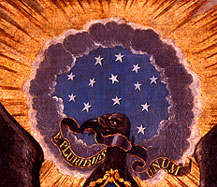|

Myth and Misinformation
about the Obverse Side of the Great Seal
The American Bald Eagle has always faced the olive branch in its right talon. It was the eagle on the Seal of the President who used to look the other way.
The eagle was not first a phoenix. Both an eagle and a phoenix appear together in the design suggested by the third Great Seal committee. And the phoenix was an appropriate, positive symbol "emblematical of the expiring Liberty of Britain, revived by her Descendants, in America."
Congress approved Charles Thomson's eagle design the same day he submitted it – June 20, 1782. There was no "great debate amongst the Founding Fathers" about which bird would be the national one – as suggested by The History Channel program "Secrets of the Dollar Bill."
More than a year after the Great Seal was adopted, Benjamin Franklin mused privately in a letter to his daughter about the wild turkey as a good symbol for "the temper and conduct of America."
The eagle's tail feathers do not symbolize the Supreme Court, which did not exist when the Great Seal was adopted in 1782. The number of feathers in the tail and wings are not specified in the official 1782 description of the Great Seal. Neither are the number of olives or leaves. These details are determined by artists or engravers and originally had no intended symbolic significance.
 The number thirteen is not "hidden" in the design of the Great Seal. It is specified several times: 13 stripes, 13 arrows, 13 stars.
The number thirteen is not "hidden" in the design of the Great Seal. It is specified several times: 13 stripes, 13 arrows, 13 stars.
The shape of each star is not described. There was no intended symbolic significance to whether a star has five points or six. This detail is also for artists and engravers to decide.
It is alleged that George Washington requested the constellation of 13 stars to be shaped into a hexagram (two intersecting triangles that form a six-pointed star), because that's also the shape of the Star of David – supposedly as a way of thanking the Jewish patriot Haym Salomon for his service to the country, particularly his financial help during the Revolution. But this story is only a legend with no evidence to support it.
|

